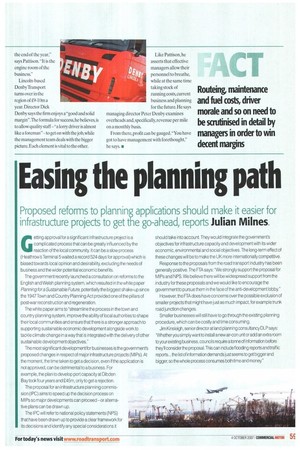Easing the planning path
Page 59

If you've noticed an error in this article please click here to report it so we can fix it.
Proposed reforms to planning applications should make it easier for infrastructure projects to get the go-ahead, reports Julian Miines,
Gcuing approval for a significant infrastructure project is a complicated process that can be greatly influenced by the reaction of the local community It can be a slow process (Heathrow's Terminal 5 waited a record 524 days for approval) which is biased towards local opinion and desirability, excluding the needs of business and the wider potential economic benefits.
The government recently launched a consultation on reforms to the English and Welsh planning system, which resulted in the white paper Planning bra Sustainable Future, potentially the biggest shake-up since the 1947 Town and Country Planning Act provided one of the pillars of post-war reconstruction and regeneration.
The white paper aims to "streamline the process in the town and country planning system, improve the ability of local authorities to shape their local communities and ensure that there is a stronger approach to supporting sustainable economic development alongside work to tackle climate change in a way that is integrated with the delivery of other sustainable development objectives."
The most significant development for businesses is the government's proposed changes in respect of major infrastructure projects (MIPs). At the moment, the time taken to get a decision, even if the application is not approved, can be detrimental to a business. For example, the plan to develop port capacity at Dibden Bay took four years and £45m, only to get a rejection.
The proposal for an infrastructure planning commission (IPC) aims to speed up the decision process on MIPs so major developments can proceed -or alternative plans can be drawn up.
The I PC will refer to national policy statements (NPS) that have been drawn up to provide a clear framework for its decisions and identify any special considerations it should take into account. They would integrate the government's objectives for infrastructure capacity and development with its wider economic, environmental and social objectives. The long-term effect of these changes will be to make the UK more internationally competitive.
Response to the proposals from the road transport industry has been generally positive. The FTA says: "We strongly support the proposal for MIPs and NPS. We believe there will be widespread support from the industry for these proposals and we would like to encourage the government to pursue them in the face of the anti-development lobby."
However, the PTA does have concerns over the possible exclusion of smaller projects that might have just as much impact, for example trunk road junction changes.
Smaller businesses will still have to go through the existing planning procedure, which can be costly and time consuming.
Jim Kinsleigh, senior director at land planning consultancy DLP says: "Whether you simply want to install anew air-con unit or add an extra room to your existing business, councils require a tonne of information before they'll consider the proposal. This can include flooding reports and traffic reports... the list of information demands just seems to get bigger and bigger, so the whole process consumes both time and money."


























































































































































































